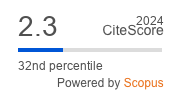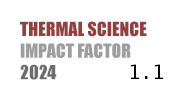ABSTRACT
Searching for ways to improve the thermophysical properties of insulating oils used in power transformers is crucial to increasing heat transfer efficiency and keeping this effective device in the electrical network as long as possible. Nanotechnology has provided promising solutions for highvoltage engineers to use in enhancing the thermal properties of dielectric fluids through the thoughtful incorporation of nanoparticles. This study presents a numerical modeling of the thermophysical properties of dielectric nanofluids based on the finite element method. To shed light on the role of nanoparticles in improving the thermal performance of mineral oils, three types of conductive, semiconducting and insulating nanoparticles were used separately in the dielectric fluid (SiC, TiO2, and Al2O3) and at different volume concentrations (0 vol%, 0.25 vol%, 0.44 vol%, 0.62 vol%, 1.1 vol%). Furthermore, the physical properties were measured over a large temperature range of 20°C to 80°C The results showed an increase in the value of thermal conductivity, viscosity, and density of the insulating fluid when NPs were added, where the effect was more evident with the integration of larger quantities of nanoparticles. This increase was suppressed by the change in temperature. The improved thermal conductivity contributes to enhancing the cooling capacity, but the high viscosity and density of the nanofluids lead to a decrease in pressure and an increase in pumping requirements. On the contrary, a reduction in the specific heat capacity of mineral oil was observed at addition of nanoparticles, which can negatively affect the thermal performance.
KEYWORDS
PAPER SUBMITTED: 2024-12-30
PAPER REVISED: 2025-02-26
PAPER ACCEPTED: 2025-03-05
PUBLISHED ONLINE: 2025-04-05
- Zhang, Y., et al., Artificial intelligence-aided thermal model considering cross-coupling effects, IEEE Transactions on Power Electronics, 35(2020), No. 10, pp. 9998-10002
- Mzili, T., et al., Hybrid Genetic and Penguin Search Optimization Algorithm (GA-PSEOA) for Efficient Flow Shop Scheduling Solutions, Facta Universitatis-Series: Mechanical Engineering, 22(2024) , No.1, pp.77-100
- Nosonovsky, M., Triboinformatics: Machine Learning Methods for Frictional Instabilities, Facta Universitatis-Series: Mechanical Engineering, 22(2024), No.3, pp.423-433
- Qi, H.S., et al., Application of Artificial Intelligence Control in the Control System of Cooling and Heating Energy Stations, Thermal Science, 28(2024), No.2B, pp.1321-1328
- Wahjd, N.S., et al., Numerical and Statistical Analyses of a Natural Convection Radiative Hybrid Nanofluid Flow on a Vertical Permeable Plate, Thermal Science, 28(2024), No.5, pp. 4209-4221
- Manikandan, S., & Nanthakumar, A.J.D., Development of a Predictive Model for Thermal Conductivity in Graphene Nanoplatelets Infused Damper Oil Using ANN/RSM, Thermal Science, 28(2024), No.5, pp.4235-4247
- Liu, Y.P., et al., Clover-Inspired Fractal Architectures: Innovations in Flexible Folding Skins for Sustainable Buildings, Fractals, 2025, DOI
- Li, X.X., et al., Elucidating the fractal nature of the porosity of nanofiber members in the electrospinning process. Fractals, 32(2024), No.6, 2450109
- Liu, Y.P., et al., Leveraging lotus seeds' distribution patterns for fractal super-rope optimization, Fractals, 2024, doi: 10.1142/S0218348X24501433
- He, C.H. and Liu, C., Fractal dimensions of a porous concrete and its effect on the concrete's strength, Facta Universitatis Series: Mechanical Engineering, 21(2023) , No.1, pp.137-150;
- He, C.H., et al., A novel bond stress-slip model for 3-D printed concretes, Discrete and Continuous dynamical Systems-Series S, 15(2022), No.7, pp.1669-1683
- He, J.H., Transforming frontiers: The next decade of differential equations and control processes. Advances in Differential Equations and Control Processes, 32(2025), No.1, 2589. doi.org/10.59400/adecp2589 [13] Darzi, A.A. R., et al., Utilizing neural networks and genetic algorithms in AI-assisted CFD for optimizing PCM-based thermal energy storage units with extended surfaces, Thermal Science and Engineering Progress, 54(2024), Sept., 102795,
- Lei, Y., Construct a deep meta-learning model for accurate outdoor thermal comfort prediction and its application. Int. J. Environ. Sci. Technol.,2024, doi.org/10.1007/s13762-024-06099-1
- Rautela, K.S., Goyal, M.K. Transforming air pollution management in India with AI and machine learning technologies. Sci. Rep., 14(2024), 20412
- Feng, Y., et al. Application of physics-informed neural networks (PINNs) solution to coupled thermal and hydraulic processes in silty sands. Geo-Engineering 16(2025), No.3, doi.org/10.1186/s40703-025-00232-w
- He, J.H., et al., Magneto-radiative gas near an unsmooth boundary with variable temperature, International Journal of Numerical Methods for Heat & Fluid Flow, 33(2023), No.2, pp.545-569
- Zhu, CY. Optimizing and using AI to study of the cross-section of finned tubes for nanofluid-conveying in solar panel cooling with phase change materials, Engineering Analysis with Boundary Elements, 157(2023), Dec., pp.71-81
- Ogunseye, H.A., et al. Entropy generation in Casson-Williamson-Powell-Eyring hybrid ferrofluid flow in a microchannel: Adomian decomposition and deep neural networks approaches. Colloid Polym Sci (2025). doi.org/10.1007/s00396-025-05384-w
- He, C.H., et al., A fractal-based approach to the mechanical properties of recycled aggregate concretes, Facta Universitatis, Series: Mechanical Engineering, 22(2024), No.2, pp.329-342
- Liu, J.J., Two-dimensional heat transfer with memory property in a fractal space, Thermal Science, 28(2024), 3A, pp. 1993-1998
- Lin, L and Zhao, L., Fabric color formulation using a modified Kubelka-Munk theory considering thermal effect, Thermal Science, 27(2023), No. 3A, pp.1811-1818
- Shang, C.H., et al., Surface roughness measurement using microscopic vision and deep learning, Frontiers in Physics, 12(2024), Jul., 1444266
- He, J.H., et al., Pull-in stability of a fractal MEMS system and its pull-in plateau, Fractals, 30(2022), No.9, DOI 10.1142/S0218348X22501857
- Tian, Y. & Shao, Y.B., Mini-review on periodic properties of MEMS oscillators. Frontiers in Physics, 12(2024), 1498185, DOI:10.3389/fphy.2024.1498185
- He, J.-H., An Old Babylonian Algorithm and Its Modern Applications, Symmetry 16(2024), 1467. doi.org/10.3390/sym16111467
- Raissi, M., et al., Physics-informed neural networks: A deep learning framework for solving forward and inverse problems involving nonlinear partial differential equations, Journal of Computational Physics, 378(2019), Feb., pp. 686-707,
- Karniadakis, G. E., et al., Physics-informed machine learning, Nature Reviews Physics, 3(2021),No.6, pp.422-440
- Suh, Y., Chandramowlishwaran, A. & Won, Y. Recent progress of artificial intelligence for liquid-vapor phase change heat transfer. NPJ Comput Mater 10(2024), 65 . doi.org/10.1038/s41524-024-01223-8

